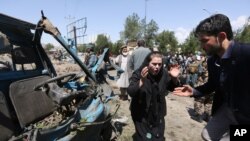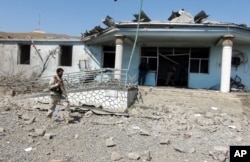Afghan officials say at least eight people were killed and more than 100 others were wounded in a powerful blast that struck downtown Kabul early Friday.
Sources said that the bomb exploded near a government compound and that many women and children were among the casualties.
No group claimed responsibility for the attack immedately, which came a day after a suicide truck bomb south of Kabul killed at least six people in the Taliban's first major attack since confirmation last week of the death of its longtime leader, Mullah Mohammed Omar.
At least three police and three civilians were killed in the massive blast late Thursday in Puli Alam, the capital of Logar province, according to local government officials. Dozens were also said to be wounded.
Also Thursday, Afghan officials said a military helicopter crashed in the southern part of the country, killing 17 soldiers.
Afghan Defense Ministry officials said the Russian-built MI-17 helicopter was transporting soldiers for redeployment when it went down in the Shinkai district of Zabul province.
Afghanistan's defense ministry said technical problems led to the crash. Other officials stressed the incident was still under investigation.
A Taliban spokesman claimed its fighters shot down the aircraft and put the death toll at 25 people, but no independent confirmation was available. Also, the claim was questioned because it is rare for insurgents to take down a military aircraft.
The violence came as the United States prepares to pull out its troops from Afghanistan by the end of 2016. The U.S.-led NATO forces already declared an end to their combat mission in December and have gradually been shifting responsibility for security operations to Afghan forces.
Speaking in Washington this week, NATO’s Afghan support mission commander, General John Campbell, said Afghan security forces continue to progress.
“We started probably late on growing their air force, so we are going to be there for a while to continue to work hard on the air force,” he said.
Campbell said attrition among Afghan forces is a bigger challenge than battlefield casualties.
"They [Afghan forces] lose probably in the neighborhood of 4,000 [personnel] per month. ... The biggest case is folks that go AWOL, absent without leave. ... When you are fighting all the time, when you need to take a break and you have no other way, then you go back home and you do not come back," he said.











